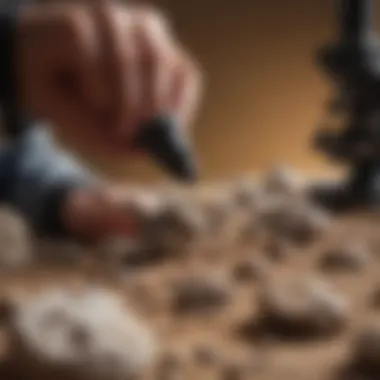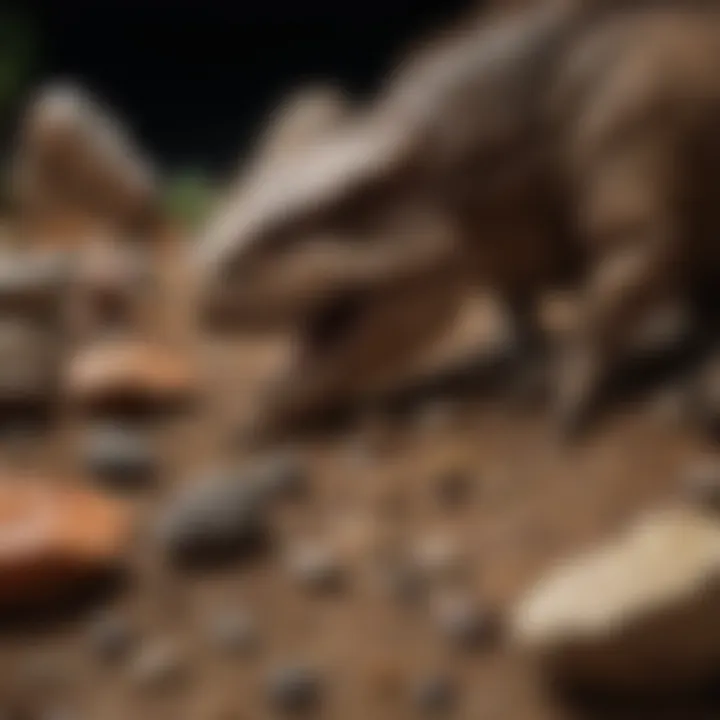Exploring Fossilized Dinosaur Excrement: Insights and Implications


Intro
Fossilized dinosaur feces, known as coprolites, might not be the first thing that springs to mind when thinking about dinosaurs. Yet, these ancient remnants provide a treasure trove of information about the lives of these magnificent creatures and their surroundings. Imagine stumbling upon a piece of history embedded in stone—a small chunk of what once was a meal. This article will shine a light on coprolites, highlighting their significance in paleontological research and the insights they lend us into the prehistoric world.
In this exploration, we will traverse through the formation of coprolites, dissect their implications for understanding ancient ecosystems, and peek into the methodologies adopted for studying these fascinating specimens. Not only are coprolites vital for uncovering the dietary habits and behaviors of dinosaurs, but they also shed light on the environmental conditions of their time. This gives a more vivid picture of how these creatures thrived, adapted, or succumbed in a world that was drastically different from our own today.
The objective is to bridge the knowledge gap between the curious enthusiasts, researchers, and fossil collectors alike. You will find practical tips for identifying and collecting coprolites, and a thorough analysis of their historical significance. By the end of this article, it's our intention to foster a deeper appreciation for these unique fossils and equip you with the knowledge needed to approach them with both respect and scientific curiosity.
Understanding Coprolites
The exploration of coprolites—fossilized dinosaur feces—provides a unique window into the lives of these magnificent creatures that roamed the Earth millions of years ago. Understanding coprolites is vital for multiple reasons, both for academic research and for enthusiasts interested in prehistoric life. They are more than mere remnants of digestion; they hold essential clues about the ecosystems of the past.
By studying coprolites, paleontologists can glean insights into the dietary habits of dinosaurs. Rather than relying solely on skeletal remains, which may provide limited information, coprolites can reveal what these creatures actually consumed, including plants, insects, or other animals.
Furthermore, examining coprolites allows scientists to reconstruct ancient environments and climate conditions. It's a kind of time capsule that shows not only what the dinosaurs ate but also the interrelationship of flora and fauna during their time.
In this section, we will delve into key aspects:
- Definition and Formation of coprolites
- The Geological Context in which these fossilized wastes are found
By peeling back the layers of understanding what coprolites represent, we can appreciate their significance in reconstructing our planet's distant past.
Definition and Formation
Coprolites are defined as fossilized feces, an often-overlooked aspect of the fossil record. They form when the original feces undergoes a series of diagenetic processes that preserve their structure over millions of years. This transformation involves several factors including mineralization, compaction, and chemical alteration.
Interestingly, the very act of fossilization can favor certain environmental conditions. For instance, coprolites are more likely found in sedimentary rocks that were once riverbeds or lake bottoms, where anaerobic conditions can slow decomposition.
Why is this important? Understanding how coprolites form not only informs us about the conditions necessary for preservation but can also tell geologists about the ancient climates at the times they were deposited. It’s essential knowledge for anyone interested in the interplay between biology and geology.
The Geological Context
The geological context pertains to the layers of earth in which coprolites are found, offering critical information about their age and origins.
Stratigraphy of Coprolite Deposits
Stratigraphy refers to the study of rock layers and layering (stratification). In the realm of coprolites, stratigraphy is instrumental. Each layer of sedimentary rock in which coprolites are discovered can be distinctly dated, often associating those deposits with specific climatic or geological events.
The most significant characteristic of stratigraphy is that it can reveal timelines of the Earth’s history. Different sediment layers can indicate how ecosystems changed over time, showcasing trends in biodiversity and extinction events. Thus, stratigraphy serves as a critical link in understanding the chronology of dinosaur existence.
One memorable feature of this stratigraphy is how it correlates with other fossil records. Coprolites are often found near bones or teeth of the same species, establishing a direct line between what dinosaurs were eating and what was available in their habitat. This makes stratigraphy a beneficial facet for this discussion; it not only helps develop a timeline but also situates coprolites within the larger framework of paleontological evidence.
However, limitations also exist. For instance, a single layer might contain coprolites from multiple species, complicating the clarity of dietary information. This is an important consideration when interpreting findings.
Taphonomy of Fossilized Feces
Taphonomy plays a critical role as it studies the processes that occur from the moment an organism dies until its discovery as a fossil. Understanding how coprolites relate to taphonomy informs us about the conditions that allowed for their preservation.
A key characteristic of taphonomy in this context is that it encompasses a variety of influencing factors—like chemical composition and environmental context. This breadth allows researchers to draw conclusions about the behaviors of the dinosaurs that produced the coprolites, including whether they were herbivores or carnivores.
A unique aspect of taphonomy is its focus on the postmortem fate of organic matter. For coprolites, this could involve decomposition rates impacting preservation or even the role of scavengers in disrupting potential fossilization. Understanding these factors can potentially expose pitfalls in how we interpret the diet and living habits of dinosaurs.
While taphonomy provides vital insights, challenges persist. The degradation of organic material over time can diminish the quality of these fossils, complicating analyses significantly. Researchers need to account for such variances when reconstructing past ecosystems based on coprolite studies.
By melding insights from both stratigraphy and taphonomy, the study of coprolites can illuminate individual aspects of the ancient world, providing a richer tapestry of life in the Mesozoic era.
Chemical Composition of Coprolites
The chemical composition of coprolites is a crucial aspect that helps researchers understand the diets and environments of dinosaurs. These fossilized feces hold a treasure trove of information, revealing not just what dinosaurs ate, but also how their waste interacted with the ecosystems of their time. By studying their chemical makeup, scientists can piece together narratives about ancient life, offering insights into the biodiversity and ecological frameworks of prehistoric periods.
Organic and Inorganic Components
Coprolites consist of a mixture of organic and inorganic components. The organic matter usually includes remains of the plants or animals that the dinosaurs consumed, such as plant cellulose, fragments of other animals, and even microorganisms. This organic fraction is often where the more informative data lies, as it can suggest specific dietary habits based on the types of plant and animal remains found.
On the other hand, inorganic components often include minerals, which can provide clues on the environmental conditions present during the time the coprolites were formed. Elements like silica, calcium, and phosphates can indicate various aspects of the surrounding soil and water chemistry. These contrasting components work in tandem, giving a fuller picture of a dinosaur’s last meals and the environment it inhabited.
Analysis Techniques
Spectroscopy
Spectroscopy serves as a powerful analysis tool when examining coprolites. This method involves measuring the light spectra emitted or absorbed by the organic materials in the fossilized waste. A key characteristic of spectroscopy is its ability to identify specific chemical bonds and functional groups within compounds. This makes it a favored choice for researchers examining coprolites since it can reveal not just components, but also the molecular structures present.
The unique feature of spectroscopy is its non-destructive nature, allowing scientists to analyze samples without damaging them. This is particularly important given the rarity of coprolites, as each specimen can provide valuable data about a specific time in the evolutionary timeline. However, a downside is that interpreting spectroscopic data can be complex and sometimes requires reference materials for accurate analysis.
X-ray Microscopy
X-ray microscopy offers another method for studying the internal structure of coprolites, providing a detailed look at their makeup. One key characteristic of X-ray microscopy is its ability to visualize the inner layers of the coprolite without slicing it open, which is essential for maintaining sample integrity. By using high-resolution imaging, researchers can discern fine details that might not be visible otherwise.
The unique feature of X-ray microscopy is its potential to map the distribution of elements across a coprolite, illustrating not only what is present, but also the concentrations of various materials. While beneficial for detailed studies, one might find that the equipment is expensive and requires specialized training to operate effectively.


In summary, both spectroscopy and X-ray microscopy contribute significant insights into the complex composition of coprolites, enhancing our understanding of these ancient artifacts. As scientists continue to develop better analytical techniques, they will undoubtedly uncover further secrets held within these fascinating remnants of dinosaur life.
Significance in Paleontological Research
Fossilized dinosaur excrement, or coprolites, serves as a treasure trove for paleontologists seeking to decipher the intricate tapestry of prehistoric life. These hardened remnants not only reveal what dinosaurs munched on but open a window into the ancient ecosystems they inhabited. Understanding the significance of coprolites transcends mere curiosity; it lays the foundation for reconstructing the behaviors, interactions, and environments of these formidable creatures.
Feeding Habits of Dinosaurs
Examining coprolites tells us more than just the diet of dinosaurs. It gives a glimpse into their feeding strategies. For instance, through detailed analysis, researchers have discovered remnants of leaves, seeds, and even bones within coprolites, painting a vivid picture of whether the dinosaur was a herbivore, carnivore, or omnivore. This identification of dietary habits can lead to broader questions about food chains and ecosystem sustainability during their reign. Thus, feeding habits inferred from coprolites can act like the keys to unlock further understanding of the biological interactions within ancient habitats.
Ecosystem Dynamics
Predator-Prey Relationships
The predator-prey dynamics illustrated through coprolite studies provide valuable insights into the balance of ancient ecosystems. Evidence of predation can be found not just within the contents, but also in the coprolite’s morphology. For instance, size and structural traits of coprolites can hint at the types of species that ingested them — large coprolites suggest bigger predators, while smaller ones might indicate young or smaller prey.
This relationship contributes to understanding the ecological niches dinosaurs occupied, outlining the chains of interaction. If scientists can determine that certain coprolites belonged to carnivorous species feeding on specific herbivores, it offers clues on dietary preferences and hunting patterns, highlighting the competitive aspects of these ancient animal societies.
"Coprolites serve as silent witnesses, echoing the habits and lives of their creators long lost to time."
Environmental Reconstruction
When the talk turns to environmental reconstruction, coprolites take center stage, acting as telltale signs of the past climate and geographical conditions. The chemical composition of coprolites can reveal climatic nuances. For example, the presence of particular plant materials indicates what vegetation thrived in that era, suggesting whether the climate was arid or lush. This information can help scientists create a detailed map of the earth’s historical landscapes.
The unique feature of this reconstruction is that it allows for a multi-faceted glimpse into our planet’s past. As coprolites provide data not limited to a single species, but rather a broader context, it assists researchers in understanding the evolutionary effects of environmental changes over time. However, attention must be paid to the potential biases, as not all ecosystems yield coprolite fossils equally, meaning some conditions might be underrepresented.
Discovering Fossilized Feces
Fossilized feces, or coprolites, are not just prehistoric leftovers; they are vital clues to understanding the lives of dinosaurs and the environments they inhabited. The study of these fossil remnants allows researchers to piece together behaviors, diets, and even the conditions of ancient ecosystems. For collectors, discovering coprolites can be a rewarding experience, offering the chance to contribute to a field that consistently reveals new knowledge about our planet's history. Beyond academic interest, the hobby brings individuals closer to the past, enriching their understanding of how ancient creatures interacted with each other and their surroundings.
Field Techniques for Collectors
For those keen on acquiring coprolites, the right field techniques can make all the difference. A successful hunt requires an understanding of where to look and how to recognize potential findings. Collectors often scour sedimentary rock formations, particularly those from the Mesozoic era, where dinosaur remnants are more prevalent. Techniques can involve:
- Honing observational skills: It's crucial to spot subtle variations in rocks that might suggest the presence of coprolites.
- Utilizing tools: Basic tools like hammers, chisels, and brushes aid in collection and preservation.
- Knowing the terrain: Certain environments, like riverbanks or exposed cliff faces, can reveal well-preserved examples due to erosion.
The thrill of finding a coprolite is akin to uncovering a hidden treasure, not just for its scientific value but also for the personal satisfaction it brings. Understanding these field techniques elevates the collecting experience, helping enthusiasts distinguish between mere stones and valuable fossils.
Legal and Ethical Considerations
When it comes to collecting coprolites, legal and ethical considerations must be top of mind. Navigating the rules ensures that collectors contribute positively to the scientific community while also respecting the environment and cultural heritage associated with fossils.
Permits and Regulations
Permits and regulations form the backbone of legal fossil collecting. Many regions require specific permissions to collect, especially on public lands or protected areas. It’s essential for collectors to familiarize themselves with local laws, as violating them can result in hefty fines or imprisonment.
These regulations not only protect the integrity of fossil sites but also contribute to conservation efforts. A key characteristic of these rules is their role in fostering respect for natural heritage and preventing commercial exploitation of these invaluable resources. The unique feature of permits lies in their ability to ensure that collecting remains a sustainable practice, allowing future generations to enjoy these resources.
Responsible Collecting Practices
In tandem with legal regulations, responsible collecting practices are also critical. This includes not only following laws but also adopting methods that minimize environmental impact. Collecting responsibly means:
- Leaving no trace: Collectors should avoid disturbing the surrounding environment where fossils are found.
- Respecting property: Always seek permission before collecting on private lands.
- Documenting finds: Keeping records of locations and conditions enhances scientific knowledge and aids future research.
By emphasizing these practices, collectors play a vital role in preserving their findings for the scientific community while ensuring that their passion does not harm the very ecosystems they seek to understand. Adopting responsible collecting is not just a benefit; it's a necessity in the quest for knowledge and appreciation of our planet's prehistory.
Famous Coprolite Discoveries
Discovering coprolites isn’t just a chance encounter; it opens a window to understanding a time long before our own. Famous coprolite discoveries shed light on the intricate web of ancient ecosystems, revealing the dietary habits and environmental conditions surrounding dinosaurs. Importantly, these findings contribute not just to paleontology but also to our broader grasp of evolutionary biology. When researchers analyze significant fossilized feces, they are uncovering clues that inform us about the past and potentially the future of species adaptation.
Notable Sites Around the World
Across the globe, certain sites have garnered fame for their remarkable coprolite discoveries. These locations, often rich in sedimentary deposits, have yielded coprolites that date back millions of years. Some notable sites include:
- Hell Creek Formation (Montana, USA): This site has produced a variety of dinosaur fossils, including coprolites from creatures like Tyrannosaurus rex. The coprolites found here are intricate, indicating what these apex predators consumed.
- Dinosaur National Monument (Colorado, USA): Not only known for its expansive fossil beds, but also for coprolite discoveries that provide insights into the diversity of herbivorous diets during the Jurassic period.
- Morrison Formation (Western USA): Well known for its wealth of dinosaur fossils, the coprolites discovered here reveal crucial information about the plant life that was present, furthering our understanding of dinosaur ecology.
- Alberta Badlands (Canada): Here, coprolites belonging to various dinosaurs including duck-billed hadrosaurs have been found, indicating the types of vegetation that formed their diets.
Each of these sites not only enriches our knowledge of prehistoric life but also serves as a reminder of the delicate balance of ancient ecosystems.
Implications of Major Finds
Major coprolite discoveries come with significant implications for paleontological research. They serve as insights into species identification and behavior, giving researchers unique viewpoints about the past.
Identification of Species
When identified correctly, coprolites can provide definitive evidence of various dinosaur species residing in specific areas. For instance, the shape and contents of coprolite can indicate whether it belonged to a herbivore or a carnivore. This specificity offers a direct connection to the dietary habits of dinosaurs:
- Shape and Texture: Coprolites from herbivores often appear more fragmented, while those from carnivores present smoother, denser forms.
- Contents: Analyzing the organic materials within coprolites helps scientists identify particular species. The presence of plant materials, seeds, or even bones can suggest what specific dinosaurs were eating.
The ability to identify species from coprolites is both a scientifically beneficial and popular approach, as it paints a clearer picture of ancient life. However, it does require meticulous examination that can lead to ambiguity in interpretation.


Insights into Behavior
The findings derived from coprolite analyses extend beyond mere dietary habits to reveal behaviors of ancient species. Such insights include:
- Feeding Patterns: The content and structure can hint at feeding behaviors, such as whether a dinosaur was a scavenger or a dedicated hunter.
- Social Interactions: Evidence from coprolites can suggest group behaviors, particularly among herbivores, indicating how these dinosaurs might have interacted with each other and their environments.
The unique features of these behaviors gleaned from coprolite studies can significantly enhance our understanding of the complex social hubs of ancient species. However, differences in environmental context can complicate these interpretations, as behavior may vary widely across different habitats.
"Fossilized feces are more than mere leftovers; they are records of life that breathe existence into the void of time."
Overall, the study of famous coprolite discoveries continues to illuminate our understanding of the past, embodying a rich narrative of life that once thrived on Earth.
Coprolites in Modern Science
The exploration of fossilized dinosaur feces, or coprolites, has taken a significant turn in the realm of contemporary scientific inquiry. Researchers are not merely digging up these ancient droppings; they are extracting vital information that reflects the rhythms of life millions of years ago. This is enhancing our understanding of prehistoric ecosystems and the organisms that inhabited them. The relevance of coprolites transcends basic paleontological interest—they are now critical in the interdisciplinary fields of biology, geology, and environmental science.
Current Research Trends
In recent studies, the analysis of coprolites has witnessed an uptick in sophistication. Techniques have been developed that enable scientists to identify not just the dietary habits of dinosaurs, but also microbial life and environmental conditions at the time of deposition. Researchers have been focusing on:
- Stable Isotope Analysis: This method is used to track the dietary preferences of dinosaurs. Different food sources leave distinct chemical signatures. By analyzing these isotopes, paleontologists can piece together a dinosaur's diet and the ecosystems they inhabited.
- Paleoenvironmental Assessment: Fossilized feces are also used to reconstruct ancient habitats. Through sediment analysis and associated flora and fauna found within coprolites, scientists can infer climate conditions of the periods in which these animals lived.
- Microfossil Recovery: There is a growing effort to recover tiny remains like pollen, spores, and even the remains of smaller organisms. These provide clues to the broader ecosystem dynamics.
Researchers are beginning to see coprolites as a fascinating window into unearthing how biology and environment intertwined in prehistoric times.
Educational Applications
In addition to their scientific value, coprolites have significant potential for educational purposes, contributing to both public engagement and formal education.
Engaging the Public
Engaging the public with the wonders of paleontology often finds a foothold in captivating narratives such as the examination of coprolites. When individuals explore where these specimens come from, they become part of a larger story of life's evolution.
The key characteristic of engaging the public lies in its ability to ignite curiosity. This element not only makes learning fun but also inspires the next generation of paleontologists and conservationists. The unique feature of this public initiative is its accessibility. Unlike many scientific topics that can appear foreboding, coprolites present an approachable and tangible topic. By discussing everyday behavior through ancient waste, the complexities of dinosaur diets become more relatable.
However, this engagement is not without challenges; skepticism exists among certain groups regarding the validity of findings based on coprolites. Yet, the educational rise of this topic is undeniable, as it often leads to deeper interest in the sciences overall—hence fostering appreciation for the intricate past that shaped our world.
Community Programs
Community programs leveraging coprolite studies serve to connect local groups with science. From hands-on workshops to organizing field trips, these programs have attracted a diverse set of participants—from school children to seasoned collectors. The essential aspect of these programs is the focus on hands-on learning. This approach creates opportunities for community involvement where participants can sift through samples for real fossils, honing skills that can transition into future academic pursuits.
One of the unique features of these initiatives is their ability to personalize learning. Instead of a dry lecture, individuals can leave with actual specimens, forging a connection with the past that traditional classroom experiences often lack. The advantage lies not only in heightened interest but also in fostering a collaborative spirit, as individuals share findings and research within their communities.
Yet, one must be cautious of oversights in community programs, such as misinformation regarding the significance of what participants discover during activities. However, as educators ensure accuracy, these programs remain vital in bridging the gaps between science and community awareness.
Preservation and Care of Coprolites
When dealing with coprolites, often considered the unsung heroes of paleontological research, their proper preservation and care is paramount. These fossilized remnants can yield a wealth of information about ancient diets and ecosystems; however, they can easily fall victim to degradation if not handled correctly. The importance of preserving coprolites extends beyond mere aesthetics; it ensures that they remain available for future study and appreciation.
Collection Techniques
Collecting coprolites involves a careful approach, ensuring both the physical integrity of the specimen and adherence to legal guidelines. Field collectors need to be equipped with the right tools, like brushes and soft trowels, to gently excavate these delicate fossils from their matrix. Ideally, utilizing a portable excavation kit can help minimize damage during retrieval. Moreover, documenting the location and stratum of each find serves as a critical piece of context for subsequent analysis.
Additionally, utilizing proper protective gear and preservation containers during transportation can enhance the ability to conserve the specimen. It's worth mentioning that the goal here is to strike a balance between curiosity and care!
Displaying Fossils in Collections
Fossils tell a story, but that tale can only be told if the artifacts are presented thoughtfully. As collectors take pride in exhibiting their coprolites, it's crucial to use display methods that not only highlight the unique features but also protect the fossils from potential harm.
Best Practices for Storage
Storing coprolites properly is a vital aspect of any collector's regimen. Effective storage requires the use of acid-free materials that won’t leach harmful chemicals into the specimens. For instance, placing coprolites in clear, sealed containers protects them from dust and moisture, which can lead to further degradation. The key characteristic here is stability, which allows for varied environmental conditions without affecting the specimens' integrity.
A benefit of using specific storage solutions, like climate-controlled display cases, is that they create a safe haven for these valuable artifacts. They not only shield the fossils from harmful UV light but also regulate temperature and humidity, conditions that can significantly impact the longevity of the material.
However, it's essential to ensure that the chosen storage doesn't lead to visual monotony; using display mounts that elevate and highlight the specimen can maintain interest without compromising safety.
Maintaining Integrity
Another key consideration in the care of coprolites is maintaining their structural integrity. Ensuring that the fossils remain intact and free from stress during handling and transportation is crucial. One effective approach is to limit frequent handling; this means using gloves whenever touching the specimens and minimizing direct contact as much as possible.
The unique feature here is the use of stabilization techniques—these involve applying lightweight supporting structures if a coprolite has cracks or flaws, which can prevent deterioration over time. This not only aids in preservation but also is a beneficial strategy for those who plan to display these artifacts publicly.
In this article, we recognise that while there’s often a tug-of-war between accessibility and preservation, striking the right balance can keep these fascinating relics viable for both study and admiration.
"The study of coprolites is not merely an archaeological endeavor; it is a bridge to understanding prehistoric life in vivid detail."
In summary, the preservation and care of coprolites requires a meticulous approach that prioritizes their long-term viability. By employing best practices for storage and maintaining their integrity through careful handling and stabilization techniques, collectors can ensure that these windows to the past are protected, allowing future generations to uncover and explore the stories embedded within.
Challenges in Coprolite Study


Fossilized dinosaur excrement, or coprolites, while rich in potential discoveries, present a unique set of hurdles that many paleontologists and researchers have to navigate. Understanding the challenges in coprolite study is crucial for a comprehensive exploration of these fossils. This section will delve into the specific elements that complicate the study of coprolites and why recognizing these challenges is essential for accurate interpretations of ancient ecosystems.
Methodological Limitations
One of the first balancing acts that researchers encounter is the methodological limitations in analyzing coprolites. Unlike more traditional fossilized remains, coprolites come with challenges that can skew analyses.
- Fragmentation: Coprolites are often broken down into smaller pieces, making it tricky to identify the original shape or size of the fecal matter. This fragmentation can lead to misinterpretations regarding the species or dietary habits of the creature that produced it.
- Contamination: Environmental factors, such as moisture and microorganisms, can alter the chemical composition of coprolites. If not recognized early on, this contamination can lead researchers to mistakenly conclude about the dietary habits or health of the dinosaur.
- Analytical Techniques: Not all methodological tools are equally suited for coprolite analysis. Techniques like scanning electron microscopy and stable isotope analysis could provide key insights, but each of them have their own limitations in what they can effectively reveal about the sample.
Controversies in Interpretation
Another layer of complexity relates to the controversies surrounding the interpretation of data derived from coprolite studies. These discussions can become heated among scientists with differing viewpoints, often based on the same data set.
- Dietary Declarations: While coprolites can provide insights into a dinosaur's diet, there's sometimes a large gap between what is found in samples and making definitive statements about feeding habits. For example, a coprolite may contain plant material, but it could either be from the dinosaur's diet or simply ingested accidentally while feeding. This ambiguity can lead to different interpretations.
- Ecological Context: Another significant conflict is understanding the ecological context surrounding coprolites. Scholars may disagree on how to correlate coprolite findings with environmental conditions of the time. Did a particular food source drive dinosaur behavior or was it a result of scarce resources? Different hypotheses abound, often leading to ongoing debate.
"Understanding the methodological limitations and navigating the controversies of coprolite interpretation is akin to piecing together an intricate puzzle—a single piece can change the entire image of ancient existence."
Overall, the importance of these challenges cannot be understated. A clearer comprehension enables researchers to not only bridge gaps in current knowledge but also to pave the way for future exploration and study of coprolites. Only by addressing these hurdles can the community continue to unearth the rich histories locked away in these remarkable fossils.
The Role of Citizen Science
Citizen science plays a significant role in broadening our understanding of coprolites and their implications for paleontology. This form of public participation fosters collaboration between amateur collectors and professional researchers, creating valuable opportunities for data gathering and analysis. In many ways, it democratizes science, allowing everyday enthusiasts to contribute to research in meaningful ways.
Engagement of amateur collectors can lead to discoveries and insights that might otherwise remain hidden. With many collecors across the world, their contributions help build a rich database of findings, showcasing both local and global coprolite evidence.
Engagement of Amateur Collectors
The involvement of amateur collectors in the study of coprolites is vital for several reasons. First and foremost, it amplifies the number of potential observations in the field. Many collectors spend significant time at various geological sites, often uncovering unique specimens that professionals may overlook. This grassroots engagement enhances the field of paleontology by introducing an additional layer of data collection.
Moreover, amateur collectors frequently form their own communities where knowledge sharing occurs. These networks serve as platforms for discussions on techniques, identifications, and locations likely to yield finds. Such collaboration can lead to collective findings that benefit all within the community.
Contributions to Research
The contributions of amateur collectors to research manifest mainly in two areas: data collection and field reporting. These two elements form the backbone of citizen science initiatives in paleontology, allowing the bridge between formal scientific inquiry and community participation.
Data Collection
Data collection in the realm of coprolites provides an essential foundation for understanding ancient ecosystems. Amateur collectors often participate in structured activities, documenting their findings with regard to location, stratigraphy, and environmental context. By gathering such information, enthusiasts contribute significantly to the larger picture of dinosaur diets and landscape interactions.
One key characteristic of this data collection process is the detail-oriented approach many collectors adopt. This meticulous documentation can highlight patterns unnoticed by professional paleontologists, leading to new lines of inquiry about coprolite origin or even dinosaur behavior.
However, challenges can arise in ensuring the accuracy of data reported by non-experts. Despite these challenges, the unique feature of hobbyist data collection lies in its ability to gather vast amounts of information over numerous sites, which can complement professional research efforts effectively.
Field Reporting
Field reporting is another area where citizen scientists excel. The act of sharing findings—including photographs, sketches, and reports—enables a thriving culture of information exchange among both amateurs and professionals. This creates a feedback loop that can enhance scientific understanding and enrich community participation.
The key characteristic of field reporting is its visual and context-driven nature. It aids in conveying important nuances about the find sites, such as erosion patterns or surrounding flora, which can offer clues about the conditions under which coprolites formed. This aspect makes field reporting a valuable tool in interpreting paleoenvironments.
However, while field reporting offers many advantages, it also faces its share of limitations, particularly related to the potential for misinterpretation or misrepresentation of findings. Despite these pitfalls, the unique perspective that amateur collectors contribute through field reporting remains invaluable, fostering ongoing dialogue within the scientific community.
In summary, the role of citizen science in the study of coprolites cannot be understated. Through engagement and contributions from amateur collectors, the field of paleontology gains diverse insights, ultimately leading to a richer understanding of extinct ecosystems and the organisms that inhabited them.
Future Directions in Coprolite Research
The study of coprolites, or fossilized dung, offers a treasure trove of insights into the prehistoric world, and as technology advances, so too does our understanding of these remarkable remnants. Future directions in coprolite research stand as an important focus in paleontology, shining light on not just what dinosaurs ate but how they interacted with their environment over millions of years. Here, we delve into the two primary branches influencing the trajectory of this field: emerging technologies and interdisciplinary collaborations.
Emerging Technologies
With advancements in techniques such as DNA extraction and microscopic analysis, the potential for unlocking secrets from coprolites has never been greater. Sophisticated methods allow researchers to identify not only what ancient species existed and their diets but also to glean insights regarding their behavioral patterns and interactions with other flora and fauna.
- CT Scanning: A non-destructive method that provides thorough imaging, enabling scientists to view the internal structure of coprolites without damaging them. This method often reveals layers of organic material, helping scientists piece together the timeline of ancient diets.
- Molecular Techniques: With the help of molecular biology, it becomes possible to analyze the organic components present, leading to discoveries about what specific plants or animals were consumed by these ancient creatures. Such information provides a clearer picture of ancient ecosystems and their evolution.
These advancements not only enhance our ability to study coprolites but also engage a wider range of scientists and fostering public interest in this intriguing slice of history.
Interdisciplinary Collaborations
Research into coprolites benefits greatly from collaboration across multiple disciplines, including biology, geology, chemistry, and even anthropology. Such partnerships create a holistic approach to understanding how dinosaurs lived, interacted, and evolved.
Integrating Biology and Geology
Merging biology with geology allows researchers to examine not just the remains of dinosaurs but also their environments. This integration helps to identify the paleoecological conditions in which these creatures thrived. By analyzing the mineral composition of coprolites alongside their biological contents, scientists paint a clearer picture of the ecosystems that once existed.
Key characteristics of this collaboration include its ability to bridge gaps between different scientific analysis.
- Biology reveals dietary habits and population dynamics.
- Geology helps in understanding the sedimentary environment and gives context to the findings.
This approach is a popular choice in this field as it allows insights into the physical structure of past ecosystems while addressing how organisms adapted to changing conditions over time.
Benefits of Cross-Disciplinary Studies
Cross-disciplinary studies in coprolite research further enhance the understanding of ancient life. By incorporating insights from disciplines such as chemistry and ecology, the resulting research is more comprehensive.
- Unique Feature: The capacity to leverage diverse methodologies bolsters the rigor of findings, making them more reliable.
- Advantage: Greater depth of study; researchers draw on various techniques, enriching data.
However, one must keep in mind that the complexity of bridging distinct scientific vocabularies and methodologies can sometimes present challenges in collaboration. Overall, these disadvantages are outweighed by the richness of knowledge achieved through cooperative exploration.
Interdisciplinary research not only broadens the horizons of paleontological inquiry but also enriches our understanding of past life forms and their environments by offering multiple perspectives on a shared subject.



